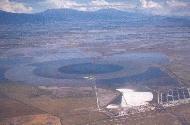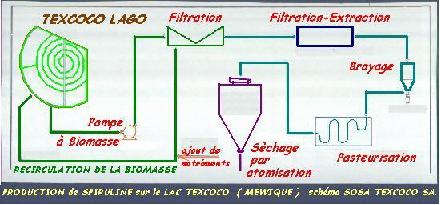
History of Spirulina
http://malnutritionzero.online.fr/sub2.htm
 |
 KANEM LAC KANEM LAC Three thousand five hundred million years ago Cyanobacteria (formerlyknown as bleu-green algae; now known as Cyanoprokaryotes) already wereflourishing on Earth. It wasn't until two thousand million years laterthat green plants, Eucaryotes, made their appearance ! The dinosaurs arrived about one hundred ninety million years ago; and we've only been here for a handfull of years by comparison.Spirulina has been around for a very long time, just waiting to help us with our nutrition problems. That's real, dedicated patience ! We don't know if earlier man recognized the food value of Spirulina, but we do know that two groups of people in historical times discovered it, had the curiosity, imagination, and courage to eat it; and profited enormously from it. These are the Aztecs of Mexico and the Kanembous of Chad. It still flourishes in Mexico and the custom of collecting, sun-drying, and preparing it never completely died out in Mexico. In Chad, Spirulina still is a staple of the diet of the people living near the small lakes in the dunes that border Lake Chad. Curious, two tribes living an ocean apart discovering this unlikely looking food and hitting upon the same techniques for separating its microscopic filaments from the water, sun-drying it, and adding it to calorie-rich foods to give themselves a complete nutrition.  About 35 years ago Hubert Durand Chastel and Maurice David of SOSA TEXCOCO, producer of carbonates from the waters of the Aztecs' Spirulina lakes in Mexico, along with Geneviève Clément of the French Petroleum Institute discovered that the bothersome microalgae in Lake Texcoco was in reality the Aztecs' super excellent food. They began commercial production in 1976, and ever since the Spirulina industry has spread worldwide and grown from a few hundred kilos to a total estimated production for 2001 of about 5000 tons. Most of it is sold through health food stores and pharmacies. It is used as food and as a means of converting carbon dioxide into oxygen by astronauts and by the crews of atomic submarines. Olympic athletes eat Spirulina for endurance as it reduces the build-up of lactic acid in muscles. Hundreds of scientific papers, theses, and popular articles have been written about Spirulina. Its value is now generally accepted, and it will not be long before production will be in the hundreds of thousands of tons per year. For more on the history of Spirulina refer to the texts given at the end of the section on composition of Spirulina.  |

